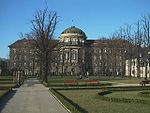Cyprian Norwid Theatre

The Cyprian Norwid Theatre in Jelenia Góra (Polish: Teatr im. Cypriana Kamila Norwida w Jeleniej Górze) is a Polish repertory theatre founded in 1945. The Norwid Theatre in Jelenia Góra has two stages: Main Stage (540 seats) and Studio Stage (100 seats). The theatre is named after Cyprian Norwid. Polish actress and stage director Alina Obidniak was an intendant of the Cyprian Norwid Theatre between 1973 and 1988, as well as in year 2000. Obidniak invited many renowned theatre directors to Jelenia Góra, particularly Krystian Lupa, where he began his directing career with the production of Dainty Shapes and Hairy Apes by Witkacy (1978). She travelled with the theatre's productions across Europe and South America. In 1983, the Cyprian Norwid Theatre co-organised early Festival of Street Theatre in Jelenia Góra.
Excerpt from the Wikipedia article Cyprian Norwid Theatre (License: CC BY-SA 3.0, Authors, Images).Cyprian Norwid Theatre
27 Grudnia, Poznań Stare Miasto
Geographical coordinates (GPS) Address Website Nearby Places Show on map
Geographical coordinates (GPS)
| Latitude | Longitude |
|---|---|
| N 52.4086 ° | E 16.9237 ° |
Address
Teatr Polski
27 Grudnia 8/10
61-737 Poznań, Stare Miasto
Greater Poland Voivodeship, Poland
Open on Google Maps










